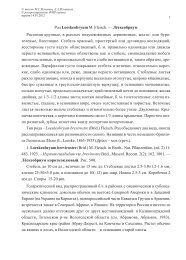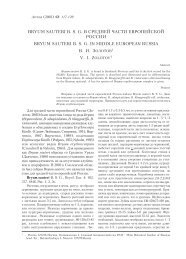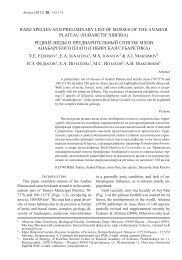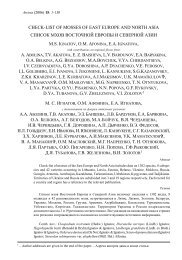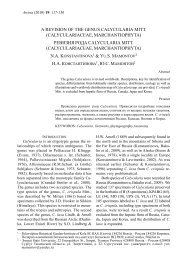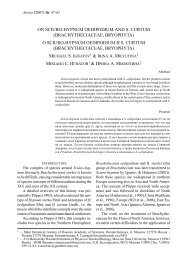THE GENUS BRYUM (BRYACEAE, MUSCI) IN MIDDLE ... - Arctoa
THE GENUS BRYUM (BRYACEAE, MUSCI) IN MIDDLE ... - Arctoa
THE GENUS BRYUM (BRYACEAE, MUSCI) IN MIDDLE ... - Arctoa
Create successful ePaper yourself
Turn your PDF publications into a flip-book with our unique Google optimized e-Paper software.
156<br />
The study area includes Middle European Russia<br />
(i.e., European Russia, excluding the Caucasus<br />
and northern territories: the Kola Peninsula, Karelia,<br />
Northern half of Leningrad/St.-Petersburg<br />
Province, and northern Arkhangelsk Province and<br />
the Komi Republic, and including the Ural Mountains<br />
up to the northern border of Perm and<br />
Sverdlovsk/Ekaterinburg Provinces).<br />
All Bryum collections from the study area in<br />
MW, MHA, LE and VOR have been examined, as<br />
well as some from H and local Russian herbaria,<br />
including Tver State University, Ekaterinburg Pedagogical<br />
University, Institute of Ecology (Ekaterinburg),<br />
and Volgograd Pedagogical University.<br />
Altogether, approximately 700 specimens were<br />
studied. Several species cited in publications pertaining<br />
to Middle European Russia were not available<br />
for study, and these are cited in the section<br />
“unconfirmed records”.<br />
Measurements in species descriptions are based<br />
on ten specimens from different parts of the territory,<br />
if this number was available. The number of<br />
specimens studied is indicated in parentheses after<br />
“specimens studied”. Species known only from<br />
sterile plants are supplemented with descriptions<br />
of sporophytes (and sometimes perigonia and<br />
perichaetia) based on other, mostly European collections,<br />
which are listed in Appendix 1. All data<br />
from outside of our area are in square brackets.<br />
The SEM analyses of peristome and spores include<br />
several species from outside of the study<br />
area, and a number of these are used to illustrate<br />
particular character states.<br />
ANALYSES OF CHARACTER STATES<br />
Sexual condition traditionally has been considered<br />
one of the important characters in Bryum<br />
taxonomy, because most species are invariable<br />
in this respect. In some groups, the differences<br />
in sexual condition were treated as an important<br />
basis for species segregation, e.g., with<br />
Bryum pseudotriquetrum–B. bimum, B. pallescens–B.<br />
lonchocaulon–B.creberrimum, and B.<br />
capillare–B. torquescens. However, recent authors<br />
have expressed doubts about the significance<br />
of this character, which (along with other<br />
evidence) has led some to reduce the status<br />
of B. bimum to a variety or a synonym with B.<br />
pseudotriquetrum, and to treat B. lonchocaulon<br />
(as B. cirrhatum) as synonymous with B.<br />
pallescens. Sexual condition was found, in the<br />
present study, to be fairly stable. The most puz-<br />
V. I. ZOLOTOV<br />
zling case is the group, B. pallescens–B. lonchocaulon–B.<br />
creberrimum; it is discussed in<br />
detail under the first species.<br />
Male and female plants of dioicous species are<br />
often in separate tufts, but in some species both<br />
sexes can be often found in the same tuft (for<br />
example, in B. pseudotriquetrum), at least if the<br />
collection is large. Male plants are usually slender,<br />
more loosely foliate (B. pallens, B. caespiticium),<br />
or almost identical with female plants (B.<br />
schleicheri). Perigonia are usually about as long<br />
as wide, and have a + capitate shape, but in some<br />
species (B. schleicheri, B. pseudotriquetum) with<br />
especially numerous antheridia, perigonia are wide,<br />
i.e., noticeably wider than long.<br />
Plants grow as separate individuals scattered<br />
on the substrate (often in B. funkii, sometimes<br />
in B. argenteum), or form loose (B. weigelii),<br />
compact (B. bimum), or dense tufts (B. caespiticium).<br />
I call a tuft ‘compact’ if a complete shoot<br />
can be pulled off the tuft from above, whether<br />
dry or wet. Correspondingly, I call a tuft ‘dense’<br />
if a shoot usually breaks in attempts to pull it<br />
from above, and the separation of a single shoot<br />
requires first a splitting of a tuft and then the<br />
careful removal of a plant from the opening. The<br />
compact or dense states are generally dependent<br />
on the density of rhizoidal tomentum, but they<br />
are not correlated in all cases. Therefore, tuft<br />
density can be treated as a separate character.<br />
The height of tufts is a complex parameter resulting<br />
from the length of female shoots, the length<br />
of subterminal shoots, and the mode of growth<br />
(shoots are mostly straight, or sometimes ascendant,<br />
as in B. rubens, B. laevifilum, or shady phenotypes<br />
of B. capillare, and includes both living<br />
and dead, partly decayed parts). Tufts vary from<br />
low (less than 0.5 mm, as in B. violaceum) to tall<br />
(10-12 cm, as in B. pseudotriquetrum, B. schleicheri,<br />
B. weigelii).<br />
Tuft color can be pure green (B. capillare),<br />
light green (B. rubens), dirty green (often in B.<br />
turbinatum), pale green (often in B. weigelii), yellow-green<br />
(B.cirrhatum), brownish-green (sometimes<br />
in B. bimum), brownish-yellow (sometimes<br />
in B. elegans), pinkish to vine-red (often in B.<br />
pallens), glaucous (sometimes in B. laevifilum and<br />
B. turbinatum), whitish (B. funkii), silvery (B.<br />
argenteum), or variegated with a mixture of green,<br />
yellow-brownish and purplish (B. alpinum). Tufts<br />
can be dull (B. weigelii) or glossy (B. alpinum).



